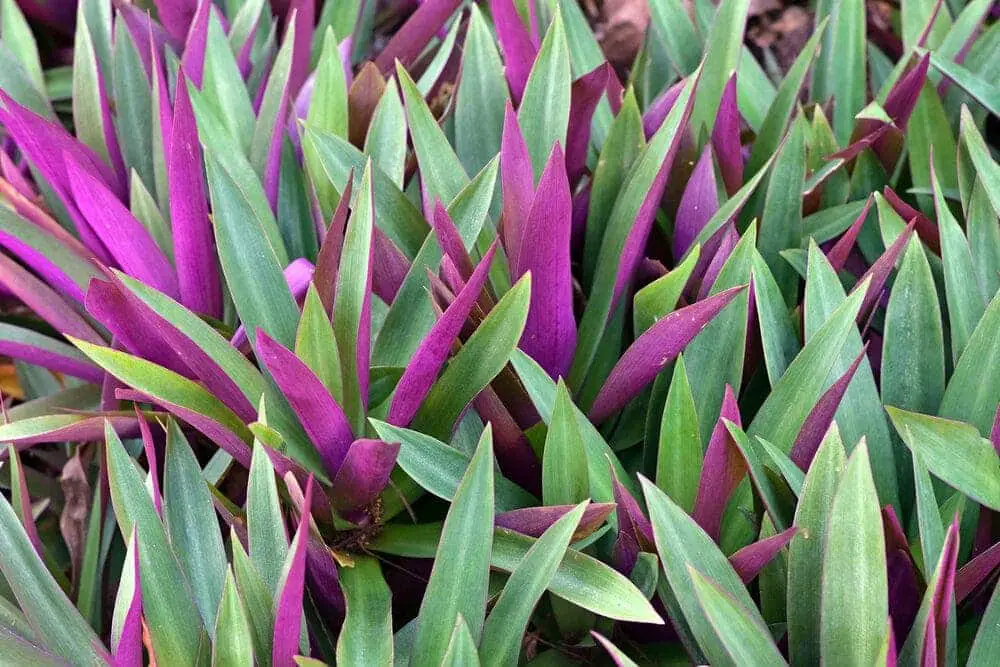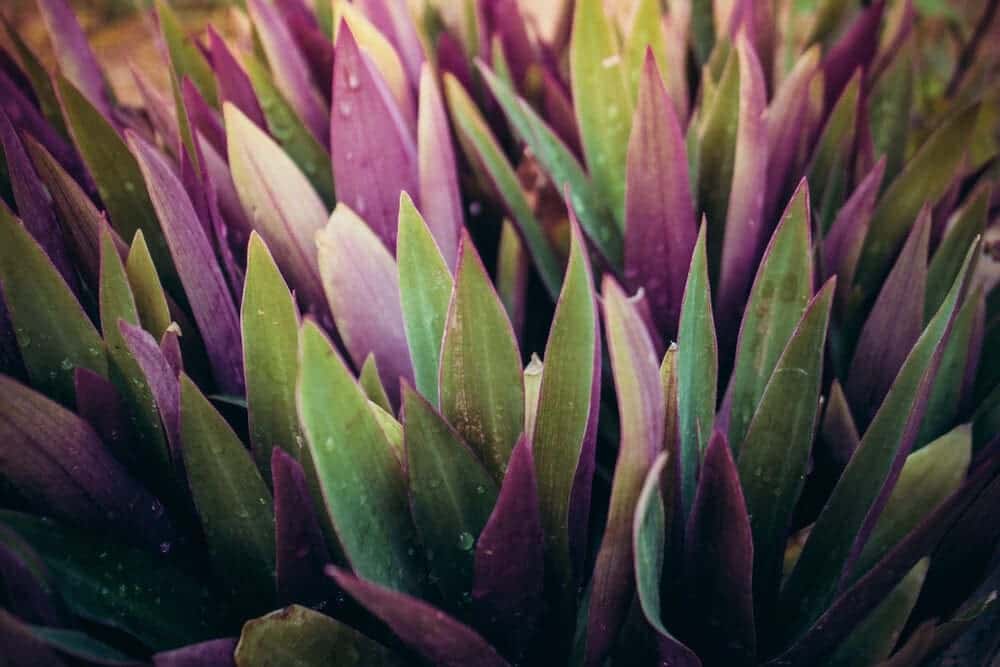The Oyster Plant is easy to grow and very colorful, making it an excellent choice for most people.
There really isn’t anything about this plant that makes it difficult to care for. If you want to introduce some bright foliage to your garden, this is an option that you’ll want to learn all about.
Oyster Plant Care & Growing Guide
1. Light Requirement
This plant needs bright indirect sunlight during the day to grow healthy and stay that way. While these plants can survive when grown in partial shade, they are far less likely to thrive. When these plants are grown in the shade, their foliage tends to be duller and less vibrant.
2. Water
Feel the first inch of the plant’s soil to see if it is dry before watering. Over watering can rot the roots of the plant, which in turn may kill the plant as a whole. Keep in mind that these plants are fairly drought tolerant, so you don’t need to water them often.
3. Climate
The Oyster Plant can be grown in USDA hardiness zones of 9 through 11. These plants definitely prefer warmer climates where the average temperature remains in the low 70s. They do particularly well in tropical or semi-tropical regions.
4. Soil
Make sure that you keep your oyster plant in a well-draining soil. You’ll also want to use perlite and compost in addition to the regular potting mix. This will provide your plant with the most nutritious environment to grow and thrive in.
5. Temperature
These plants really prefer a temperature range of 65 to 86 degrees Fahrenheit. They do not handle the cold very well, which is why you need to be careful about keeping them outside in the fall and winter months.
6. Repotting
You’ll only have to worry about repotting your oyster plant if it gets too big for the container it is currently in. You should only have to do this every few years. Just go up one pot size each time you repot this plant.
You don’t want the new container to be too large, as the root system may deprive the leaves of adequate nourishment. It is usually a good idea to repot once this plant has reached four inches tall.

7. Speed of Growth
Most oyster plants grow fairly quickly when they are given bright, indirect sunlight on a daily basis.
8. Height and Spread
An oyster plant can grow up to 12 inches tall and 12 inches wide. The average size of the leaves of this plant is around five to six inches.
9. Flowers
The white, green and purple flowers that oyster plants produce will definitely add some color to your garden. While these flowers are fairly small, they are incredibly vibrant as a whole. The flowers form right from the base of the plant.
10. Trimming
The only time that you will really need to trim this tree is when there is dead foliage. If you notice any leaves on your plant with brown spots, you should make a point of cutting them off as soon as possible.
You might also need to trim your oyster tree to maintain the desired shape. Some people will need to prune this tree more than others, depending on which shape they want to keep.
Is the Oyster Plant Poisonous?
Every part of the oyster plant is considered to be poisonous, including the stem, leaves and flowers. You will therefore need to be very careful; about keeping these plants around pets and small children. The leaves of this plant can cause a terrible burning sensation in the throat if ingested.
Even just handling this plant can cause skin irritation, so you’ll need to be aware of that. You should use gloves when touching any part of this plant.
How to Get Oyster Plants to Flower
If you really want to get your oyster plant to flower, it is imperative that you grow it outside in bright indirect sunlight. You also need to make sure that you provide it with a good amount of water, but not too much.
Keep in mind that it is very difficult to get this plant to bloom when you keep it indoors. These plants require a lot of direct sunlight outside to produce flowers. While your plant might bloom inside, the flowers will likely be sparse.

Common Oyster Plant Diseases
You might find that mealy bugs are attracted to your oyster plant, and they can be quite problematic. It is important that you get these pests taken care of right away to minimize the amount of damage they do.
If you see the leaves on your plant turning brown and dying, it could be because it is getting too much sun inside. If this is the case, you should move the plant to a window that receives less direct sunlight.
Some of these plants also develop neck rot, which happens when a plant is over watered. It can also become a problem when there is not enough humidity in the air. In the latter case, you can simply spray the leaves of the plant once in a while.
Conclusion
- Oyster plants need bright but indirect sunlight.
- Too much direct sunlight can scorch and permanently damage the leaves of this plant.
- You should wait until the first inch of the plant’s soil is dry before you water it.
- Overwatering your plant can cause root rot, which usually presents as brown spots on the leaves.
- You need to grow this plant in well-draining soil with compost and perlite. This will provide the plant with adequate nourishment at all times.
- Hot, humid climates that are warm year-round are best for these plants.
- An oyster plant prefers a temperature range of 65 to 85 degrees Fahrenheit.
- You will only need to trim this plant to keep its shape or remove dead foliage.
- Repotting is usually only necessary every few years.
- If you want to get this plant to flower, make sure that you keep it outside in bright indirect sunlight.
Victoria is the owner and main author of hobby plants. She loves spending her free time in her garden planting and taking care of her plants. Victoria hopes you enjoy the content here!
![Mother Of Thousands Plant [Complete Plant Care Guide] Mother Of Thousands Plant [Complete Plant Care Guide]](https://www.hobbyplants.com/wp-content/uploads/2022/07/mother-of-thousands-plant-300x158.jpg)
![Majesty Palm Plant Care: [Complete Beginner's Guide] Majesty Palm Plant Care: [Complete Beginner's Guide]](https://www.hobbyplants.com/wp-content/uploads/2022/08/majesty-palm-care-300x158.jpg)
![Exotic Angel Plant Care: [Complete Beginner's Guide] Exotic Angel Plant Care: [Complete Beginner's Guide]](https://www.hobbyplants.com/wp-content/uploads/2022/08/exotic-angel-plant-care-300x158.jpg)
![Snow White Waffle Plant: [Complete Care Guide] Snow White Waffle Plant: [Complete Care Guide]](https://www.hobbyplants.com/wp-content/uploads/2022/08/snow-white-waffle-plant-300x158.jpg)
![Waffle Plant Care: [Complete Beginner's Guide] Waffle Plant Care: [Complete Beginner's Guide]](https://www.hobbyplants.com/wp-content/uploads/2022/08/waffle-plant-300x158.jpg)
![Bird Of Paradise Plant Care: [Complete Beginner's Guide] Bird Of Paradise Plant Care: [Complete Beginner's Guide]](https://www.hobbyplants.com/wp-content/uploads/2022/08/bird-of-paradise-plant-300x158.jpg)
![Purple Passion Plant Care: [Complete Beginner's Guide] Purple Passion Plant Care: [Complete Beginner's Guide]](https://www.hobbyplants.com/wp-content/uploads/2022/08/purple-passion-plant-care-300x158.jpg)
![China Doll Plant Care: [Complete Beginner's Guide] China Doll Plant Care: [Complete Beginner's Guide]](https://www.hobbyplants.com/wp-content/uploads/2022/09/china-doll-plant-care-300x158.jpg)
![Polka Dot Plant Care: [Complete Beginner's Guide] Polka Dot Plant Care: [Complete Beginner's Guide]](https://www.hobbyplants.com/wp-content/uploads/2022/09/polka-dot-plant-300x158.jpg)
![Mona Lisa Lipstick Plant Care: [Complete Beginner's Guide] Mona Lisa Lipstick Plant Care: [Complete Beginner's Guide]](https://www.hobbyplants.com/wp-content/uploads/2022/09/lipstick-plant-mona-lisa-300x158.jpg)
![Yucca Cane Plant Care: [Complete Beginner's Guide] Yucca Cane Plant Care: [Complete Beginner's Guide]](https://www.hobbyplants.com/wp-content/uploads/2022/09/yucca-cane-plant-care-300x158.jpg)
![Bush On Fire Croton Plant Care: [Complete Beginner's Guide] Bush On Fire Croton Plant Care: [Complete Beginner's Guide]](https://www.hobbyplants.com/wp-content/uploads/2022/09/bush-on-fire-croton-300x158.jpg)